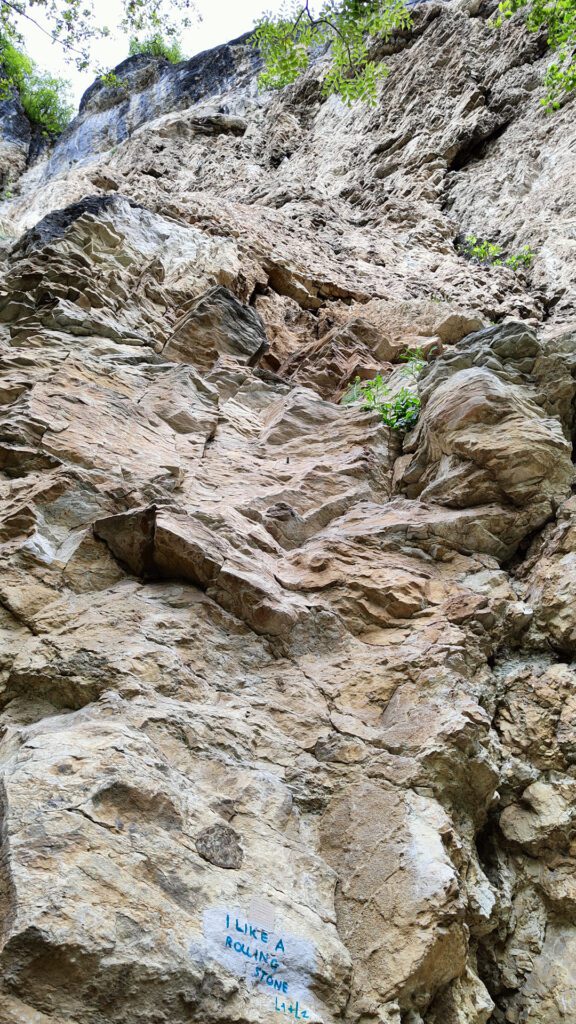Per la prima volta in Italia un’intera falesia è stata schiodata in segno di protesta contro una guida cartacea
Persona non grata: tale è, a quanto pare, diventato Michael Meisl, editore e autore della guida “Oltre Arco”, da qualche settimana acquistabile a 44 euro anche sul web. “Oltre Arco”, considerata dal punto di vista di chi scende da nord e intende proseguire le sue scalate oltre la rinomata località trentina, è una guida in pessimo inglese (e immaginiamo miglior tedesco) che descrive una buona parte delle falesie presenti dalla Val di Non in giù, fino alle porte della pianura padana, abbracciando quindi anche tutto il veronese affacciato sull’Adige.
A parte la orrenda copertina, il resto è bello e tutto sommato ben fatto, anzi assai migliore rispetto alle omologhe guide in italiano, con abbondante e chiarificatore utilizzo del drone. Quindi anche pazienza per l’inglese pieno di errori. Ma non è qui il bug.

Il bug sono le numerose falesie tenute segrete da un tempo variabile da oltre trent’anni a post covid e ora totalmente spiattellate sulle pagine della guida: Servis, Castellano, Monte Zugna, Laghetti, Falegnameria… un vero smacco per i climbers locali che erano riusciti fin qui a resistere a tante pressioni editoriali e mantenere riservate alcune aree in una zona comunque non priva di possibilità di scalata.
Fatto sta che dalle minacce i locals sono passati ai fatti: una settimana fa a Castellano si scalava; ieri, 21 aprile, non si scalava più. Sono state infatti rimosse tutte le piastrine di quasi tutte le vie, rendendo di fatto impossibile arrampicare a meno di riavvitarsi ogni tiro piastrina per piastrina. Non sono stati martellati i bulloni, il che fa pensare a una schiodatura a tempo indeterminato ma non irreversibile.
Non è la prima schiodatuta di una falesia nel nostro paese, ma è il primo caso di una schiodatura seriale eseguita per protesta contro a una pubblicazione web o cartacea.
E’ probabile che Castellano sia solo la prima di una serie di schiodature seriali, quindi stay tuned.
Le sensibilità a riguardo dell’argomento sono inevitabilmente diverse e opposte e con un milione di sfumature intermedie. Va comunque considerato che il polso reale della situazione di un luogo (proprietà dei terreni, proprietà e sicurezza dei percorsi di accesso, avifauna, punti pericolosi delle pareti ecc,,) ce l’hanno solo i locali e tante volte ci sono delle ragioni ben fondate dei motivi che fanno propendere per una limitata pubblicità delle pareti.
Noi crediamo che questi motivi non dovrebbero importare a un compilatore di guide; che si tratti di terreni privati, di possibili attriti per via dei parcheggi o o anche solo della voglia dei chiodatori di tenersi per sè un angolino del proprio lavoro, la volontà di chi ha messo i soldi, il tempo e la fatica per chiodare una parete andrebbe rispettata a prescindere. Di certo un chiodatore non può attrezzare una falesia e pretendere che nessun altro ci vada; a meno che non si tratti di un terreno recintato di sua proprietà. Attrezzare è un atto pubblico, ostacolare verbalmente o fisicamente o proprio impedire la frequentazione ad altri climbers è semplicemente illegale. Ma pretendere riservatezza per luoghi con criticità e a rischio chiusura (o gomme tagliate, litigi ecc..) è moralmente molto sensato e i compilatori di guide dovrebbero tenere in seria considerazione tali istanze.
Detto questo, la schiodatura di Castellano pone adesso diversi ulteriori temi che, trattandosi di una novità assoluta, si aprono come completamente nuovi. Immaginiamo per esempio che un singolo o un altro gruppo di chiodatori decida che il gesto dei locals sia stato sbagliato (di primo acchito, pensandoci, assomiglia infatti a quello del marito che si evira per far dispetto alla moglie) e si metta a reimbullonare tutto a sue spese. Una reiterata schiodatura aprirebbe non solo una faida, ma una possibile querelle legale.
Ipotesi numero due: un climber arriva con la guida in mano, non si rende conto della schiodatura oppure pensa di trovare spit più su lungo la parete, cade e si ferisce/ammazza: siamo sicuri che la susseguente inchiesta e richiesta di risarcimento danni non arriverebbe fino agli autori della schiodatura arbitraria? In fondo una reale schiodatura prevederebbe il martellamento dei bulloni fino a filo parete non la situazione visibile in foto, con tutti i monconi che spuntano dalla roccia…
Ricordiamo a tutti che una parete di roccia naturale accessibile a tutti (anche se su terreno privato in assenza di cartelli di divieto di accesso un luogo è accessibile a tutti), nel momento in cui vi viene imbullonato il primo fix, diventa a tutti gli effetti un impianto pubblico, anche se gratuito. Disattrezzare un impianto pubblico esistente e pubblicizzato su una guida è una responsabilità che molti potrebbero considerare al confne del reato.
Michael Meisl, da noi contattato per un commento sulla situazione, per il momento non ha ritenuto di rilasciare dichiarazioni. AGGIORNAMENTO: LA RISPOSTA DI MEISL A QUESTO LINK

For the first time in Italy, an entire crag has been cleared in protest of a paper guidebook
Persona non grata: such has apparently become Michael Meisl, editor and author of the guidebook “Beyond Arco,” which has been available for purchase for 44 euros on the web for a few weeks now as well. “Beyond Arco,” considered from the point of view of those coming down from the north and intending to continue their climbs beyond the renowned Trentino resort, is a guide in bad English (and let’s imagine better German) that describes a good part of the present crags from Val di Non down to the gates of the Po Valley, thus embracing also the whole Veronese area facing the Adige River.
Apart from the horrendous cover, the rest is beautiful and all in all well done, in fact much better than the counterpart guides in Italian, with abundant and clarifying use of the drone. So patience for the error-filled English. But that is not where the bug is.
The bug are the numerous crags kept secret for a time varying from over thirty years to post covid and now totally blurted out in the pages of the guidebook: Servis, Castellano, Monte Zugna, Laghetti, Falegnameria… a real snub for the local climbers who had so far managed to resist against many editorial pressures and keep some crags confidential in an area in any case not devoid of climbing possibilities.
The fact is that from threats the locals have moved on to deeds: a week ago in Castellano we were climbing; yesterday, April 21, they were no longer climbing. In fact, all the hangers on almost every route have been removed, making it effectively impossible to climb unless you bolt each pitch again hanger by hanger. No bolts have been hammered out, suggesting indefinite but not irreversible unnailing.
This is not the first anchors removal of a crag in our country, but it is the first case of a serial removal performed in protest against a web or print publication.
It is likely that Castellano is only the first in a series of serial actions, so stay tuned.
Sensitivities about the topic are inevitably diverse and opposing, with a million nuances in between. It should be considered, however, that the real pulse of the situation of a place (propriety of the land, propriety and safety of access routes, birdlife, dangerous spots on the walls, etc..) only the locals have it, and many times there are well-founded reasons for limited publicity of the walls.
We believe that these reasons should not matter to a guidebook compiler; whether it is on private land, possible friction over parking or even just the desire of bolters to keep a corner of their work to themselves, the will of those who have put the money, time and effort into bolting a wall should be respected regardless. Certainly a bolter cannot equip a crag and expect no one else to go there; unless it is on fenced land he owns. Equipping is a public act; verbally or physically obstructing or just preventing other climbers from going is simply illegal. But demanding confidentiality for places with criticality and at risk of closure (or slashed tires, fights, etc.) is morally very sensible, and guide compilers should give serious consideration to such instances.
That said, Castellano’s removal now poses several additional issues that, since it is a completely new issue, open up as completely new. Imagine, for example, that an individual or another group of bolters decides that the locals’ act was wrong (at first glance, thinking about it, it does indeed resemble that of the husband who emasculates himself to spite his wife) and sets about re-bolting everything at his own expense. Repeated unbolting would open up not only a feud, but a possible legal challenge.
Hypothesis number two: a climber arrives with guidebook in hand, doesn’t realize the snapping or thinks he is finding bolts further up the wall, he grounds and injures himself/kills himself: are we sure that the subsequent investigation and claim for damages would not reach the perpetrators of the arbitrary removal? After all, real removal would involve hammering the bolts up to flush with the wall not the situation visible in the photo, with all the irons sticking out of the rock…
We remind everyone that a natural rock face that is accessible to all (even if on private land in the absence of no-entry signs a place is accessible to all), the moment the first fix is bolted to it, it becomes for all intents and purposes a public facility, even if it is free. Unbolting an existing public facility advertised in a guidebook is a responsibility that many might consider little shy of a crime.
Michael Meisl, contacted by us for comment on the situation, did not wish to comment at this time.
UPDATE: MEISL’S ANSWER AT THIS LINK


Comments are closed.